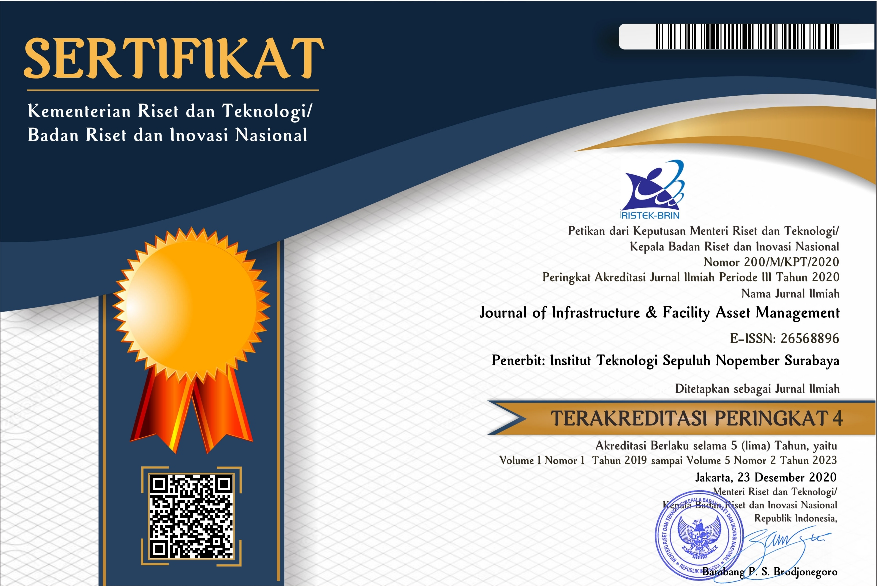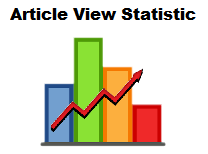Towards facilities management practice within a different environment
Abstract
Full Text:
PDFReferences
Adam, E. & Ebert, R. (1992). Production and Operations Management (5th ed). Englewood Cliffs, NJ. Prentice-Hall,
Adegoke, B.F. & Adegoke, O.J. (2013). “The use of facilities management in tertiary institutions in Osun State, Nigeria”. Journal of Facilities Management, 11(2), 183-192. DOI 10.1108/14725961311319610
Adewunmi, Y., Ajayi, C. and Ogunba, O. (2009). “Facilities management: factors influencing the role of Nigerian estate surveyors”. Journal of Facilities Management, 7 (3), 246-258. DOI 10.1108/14725960910971504
Adewunmi, Y., Omirin, M. & Koleoso, H. (2012). “Developing a sustainable approach to corporate FM in Nigeria”. Facilities. 30 (9/10),350-373. DOI 10.1108/02632771211235206
Alexander, K. (Ed.) (1996). Facilities Management: London. Theory and Practice, E&FN Spon,
Amaratunga, D., Sarshar, M. & Baldry, D. (2002). “Process improvement in facilities management: the SPICE approach”. Business Process Management Journal, 8 (4), 318 –337. http://dx.doi.org/10.1108/14637150210434982
Atkin, B. & Brooks, A. (2000). Total Facilities Management. Oxford. Blackwell Science.
Barrett, P. & Baldry, D. (2003). Facilities Management: Towards best practice. Oxford. Blackwell.
Barrett, P. (1995). Facilities Management: Towards Better Practice. Oxford. Blackwell Science.
Becker, F. (1990). The Total Workplace. New York, NY. Van Nostrand Reinhold,
Becker, F. (2003). “Integrated portfolio strategies for dynamic organizations”. Facilities, 21 (11/12), 289-98.
Chotipanich, S. (2004). “Positioning facility management”. Facilities, 22 (13/14), 364–372. DOI 10.1108/02632770410563086
Chotipanich, S. and Nutt, B. (2008). “Positioning and repositioning FM”. Facilities, 26 (9/10), 347- 88.
Grimshaw, R. (1999). “Facilities Management: the wider implications of managing change”. Facilities, 7 (1/2), 24-30.
International Facility Management Association (IFMA) (2010). Definition of facilities management. Accessed on 10 June 2018 from http://www.Ifma. Org/what is FM/Index. CFM.
Ismail, I. (1996). The Operational Property Management Process in Large Non-profit Organisation in Malaysia. Unpublished PhD thesis, University of Reading, Reading MA.
Kennedy, A. (1996). Support services. In Alexander, K. (Ed.) Facilities Management: Theory and Practice. London, E&FN Spon,
Kothari, C. (2004). Research Methodology: Methods and Techniques (2nd ed). New Delhi, New Age International (P) Limited.
Lavy, S., Garcia, J.A. & Dixit, M. K. (2010). “Establishment of KPIs for facility performance measurement: a review of the literature”. Facilities, 28 (9/10), 440-464. DOI 10.1108/02632771011057189
Loosemore, M. (2004). Aligning business, property, facilities, and services. Conference Proceeding of Future in Property and Facility Management II, a two-day international conference, University College London, Management. Bangkok Chulalongkorn, University Press, Thailand
McGregor (2000). “Preparing for an uncertain future”. Facilities, 18 (10-12), 402-410.
McLennan, P. (2004). Service management: a conceptual model for FM. Conference Proceeding of Future in Property and Facility Management II, a two-day international conference, University College London, London.
Nietubiez, R.S. and Lewis, B.T. (1999), “Programme organization”, in Lewis, T.B. (Ed.), Facility Manager’s Operation and Maintenance Handbook, McGraw-Hill, New York, NY
Nutt, B. (2004). Flexibility and versatility: ten dimensions of concern. Conference Proceedings: Futures in Property and Facility Management II: Creating a Platform for Change, UCL,
Olayonwa, G. O. (2008). Property Management: Principles and Practice. Iwo: Debo Publishing Company
Price, I. (2004). Business critical FM. Conference Proceeding of Future in Property and Facility Management II, a two-day international conference, University College London, London.
Seymour-Jones, T.J. (2017). An Assessment of International Leading Practice in the Integrated Management of Public Sector Property Assets, and its Application to the Australian Public Sector. Unpublished PhD Dissertation, submitted to the Faculty of Architecture, Design Planning University of Sydney
Slack, N. et al. (1998). Operations Management. (2nd ed.). London. Pitman Publishing.
Stephens, K. (1994). Creating enabling strategies. In Alexander, K. (Ed.), Facilities Management, CFM, University of Strathclyde, Glasgow.
Stephens, K. (1994). Creating enabling strategies. In Alexander, K. (Ed.), Facilities Management, CFM, University of Strathclyde, Glasgow.
Tay, L. & Ooi, J.T.L. (2001). “Facilities Management: A jack of all trade?” Facilities, 19(10) 357-362.
Wong, T. (2000). Culture: Its influence on facilities management in Asia. Proceeding of Facilities Management Conference. Asia, Singapore.
DOI: http://dx.doi.org/10.12962%2Fjifam.v3i3.14128
Refbacks
- There are currently no refbacks.
Visitor :
Flag Counter

Journal Of Infrastructure & Facility Asset Management by Institut Teknologi Sepuluh Nopember is licensed under a Creative Commons Attribution-ShareAlike 4.0 International License.





